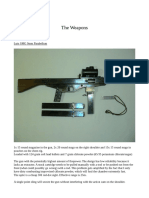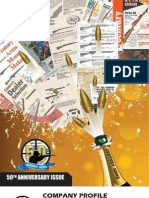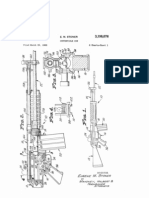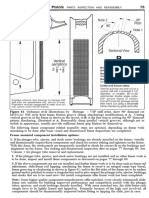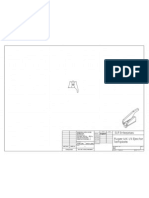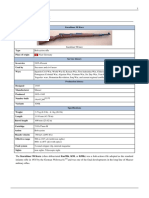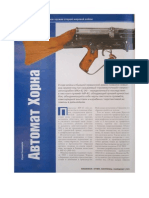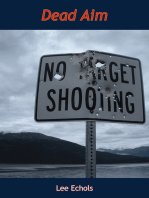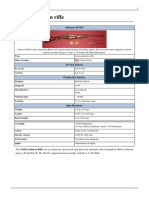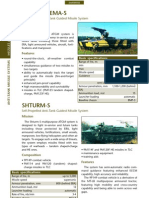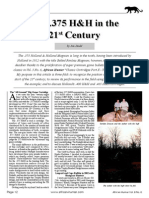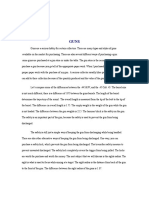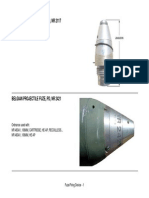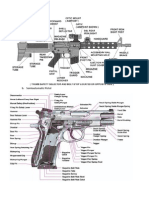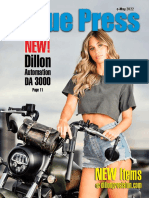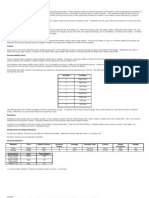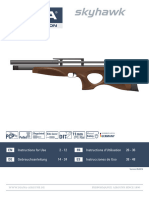W mp40
W mp40
Uploaded by
Антон ЗахаровCopyright:
Available Formats
W mp40
W mp40
Uploaded by
Антон ЗахаровOriginal Title
Copyright
Available Formats
Share this document
Did you find this document useful?
Is this content inappropriate?
Copyright:
Available Formats
W mp40
W mp40
Uploaded by
Антон ЗахаровCopyright:
Available Formats
MP 40
MP 40
Maschinenpistole 40
MP 40/I (stock extended)
Type
Placeoforigin
Submachine gun
Nazi Germany
Service history
Inservice
19391945
Usedby
See Users
Wars
World War II, Cold War (Limited)
[1]
Production history
Designer
Heinrich Vollmer
Designed
1938
Manufacturer
Erma Werke
Produced
19401945
Numberbuilt
Approx. 1 million
Variants
MP 36, MP 38, MP 40, MP 40/1, MP 41
Specifications
Weight
4kg (8.82lb)
Length
833mm (32.8in) stock extended / 630mm (24.8in) stock folded
Barrellength
251mm (9.9in)
Cartridge
9x19mm Parabellum
Action
Straight blowback, open bolt
Rateoffire
550 rounds/min
Muzzlevelocity
~380m/s (1247ft/s)
Effectiverange
100 m
Maximumrange
200 m
Feedsystem
32-round detachable box magazine
Sights
Hooded front blade, fixed and flip-up U-notch rear
The MP 38 and MP 40 (MP designates Maschinenpistole, literally "Machine Pistol") is a submachine gun developed
in Nazi Germany and used extensively by paratroopers, tank crews, platoon and squad leaders, and other troops
during World War II.[2]
MP 40
Development
The MP 40 was descended from its predecessor, the MP 38, which was
in turn based on the MP 36, a prototype made of machined steel. The
MP 36 was developed independently by Erma Werke's Berthold Geipel
with funding from the German Army. It took design elements from
Heinrich Vollmer's VPM 1930 and EMP. Vollmer then worked on
Berthold Geipel's MP 36 and in 1938 submitted a prototype to answer
a request from the German Armament services for a new submachine
gun, which was adopted as MP 38. The MP 38 was a simplification of
the MP 36, and the MP 40 was a further simplification of the MP 38,
with certain cost-saving alterations, notably in the more extensive use
of stamped rather than machined parts.
Soldiers of the Waffen-SS with MP 40
submachine guns.
Other changes resulted from experiences with the several thousand MP
38s in service since 1939, which had been used in action during the
invasion of Poland. The changes were incorporated into an
intermediate version, the MP 38/40, and then used in the initial MP 40
production version. Just over 1 million would be made of all versions
in the course of the war.
The MP 40 was often called the "Schmeisser" by the Allies, after
weapons designer Hugo Schmeisser. Schmeisser had designed the MP
18, which was the first mass-produced submachine gun, and saw extensive service at the end of the First World War.
He did not, however, design the MP 40, although he held a patent on the magazine. He later designed the MP 41,
which was an MP 40 with a wooden rifle stock and a selector, identical to those found on the earlier MP 28
submachine gun. The MP 41 was not introduced as a service weapon with the German Army, but saw limited use
with some SS and police units. They were also exported to Germany's ally, Romania. The MP 41's production run
was brief, as Erma filed a successful patent infringement lawsuit against Schmeisser's employer, Haenel.
Despite the impression given by popular culture, particularly in war films, MP 40s were generally issued only to
paratroopers and platoon and squad leaders; the majority of German soldiers carried Karabiner 98k rifles. However,
later experience with Soviet tactics - where entire units armed with submachine guns outgunned their German
counterparts in short range urban combat - caused a shift in tactics, and by the end of the war the MP 40 and its
derivatives were being issued to entire assault platoons on a limited basis.
There were never enough MP 40s to go around, because raw material and labor costs made it expensive to produce
alongside the Kar98 rifles. Starting in 1943, the German army moved to replace both the Kar-98 rifle and MP 40
with the new MP 43/44 assault rifle, also known later as the StG 44.
MP 40
Design
Both MP 38 and MP 40 submachine guns are open-bolt,
blowback-operated automatic arms. Fully automatic fire was the only
setting, but the relatively low rate of fire allowed for single shots with
controlled trigger pulls. The bolt features a telescoping return spring
guide which serves as a pneumatic recoil buffer. The cocking handle
was permanently attached to the bolt on early MP 38s, but on late
production MP 38s and MP 40s, the bolt handle was made as a
separate part. It also served as a safety by pushing the head of handle
into a separate notch above the main opening, which locked the bolt
either in the cocked or forward position. The absence of this feature on
early MP 38s resulted in field expedients such as leather harnesses with
a small loop, used to hold the bolt in forward position.[3]
The receiver was originally machined steel but this was a
time-consuming and expensive process. This prompted the
development of a simpler version that used stamped steel and
electro-spot welding as much as possible. The MP 38 also features
longitudinal grooving on the receiver and bolt, as well as a circular
opening on the magazine housing. These features were suppressed on
the M38/40 and MP 40.
A soldier of the Russian Liberation Army with an
MP 38.
MP 40, folded stock.
One idiosyncratic and visible feature on most MP 38 and MP 40 submachine guns was an aluminum, steel, or
bakelite resting bar or support under the barrel which was used to steady the weapon when firing over the side of
open top armored personnel carriers such as the Sdkfz 251 half-track. A handguard was located between the
magazine housing and pistol grip and was made of synthetic material derived from bakelite. The barrel lacked any
form of insulation, which often resulted in burns for the supporting hand if it strayed. It also had a compact folding
metal stock, the first for a submachine gun[4] , resulting in a shorter weapon when folded, but it was at times
insufficiently durable for hard use in combat.
MP 40
4
Although the MP 40 was generally reliable, a major weak point was its
32-round magazine. Unlike the Thompson's double-column, dual-feed
magazine, the MP 38 and MP 40 used a double-column, single-feed
design. The single-feed resulted in increased friction against the
remaining cartridges moving upwards towards the feed lips,
occasionally resulting in a failure to feed; the problem was exacerbated
by the presence of dirt or dust.[5] Another problem was that the
magazine was also sometimes misused as a handhold, which could
cause the weapon to malfunction when hand pressure on the magazine
body caused the magazine lips to move out of the line of feed, since the
magazine well did not keep the magazine firmly locked. German
soldiers were trained to grasp either the intended handhold on the
underside of the weapon or the magazine housing with the supporting
hand to avoid feed malfunctions.[6] [7]
Copies and post-war usage
A Wehrmacht soldier with an MP 40/I in 1944.
After the end of the Second World War, many MP40's that were
captured by the allies were redistributed as surplus weapons to many
developing countries, paramilitary and irregular forces where they ended up being used in battlefields such as
Greece, Israel, and Vietnam.[1]
The MP 38 or MP 40 was also a pattern for diverse submachine guns such as:
As the design of the M3 submachine gun started, the designers looked at Sten guns and captured MP 40s. The M3
used a copy of the Sten magazine, itself a copy of the MP 40 magazine.
The Spanish company Star Bonifacio Echeverria, S.A. produced the Star Modelo Z-45, a variant of the MP 40.[8]
Produced in 9x23mm Largo, the Z-45 is a selective-fire submachine gun, equipped with either a wooden or a
folding metal buttstock, and wooden handguards.[9] Its magazine was a copy of the MP 40, and held 30
rounds.[10] It served in Spain, Cuba, Chile, Portugal and Saudi Arabia and was used for the first time in combat in
the battle of Sidi Ifni.
The Yugoslav Peoples Army used a similar submachine gun in
7.62x25mm Tokarev produced by Zastava called the M56 which
was used in some quantity in the various conflicts after the breakup
of Yugoslavia. It was recognized by its long thin barrel, curved
magazines, and a permanently mounted folding bayonet.
The Norwegian Army used the MP 40 from 1945 until about
1970[11] and other parts of the Norwegian armed forces, such as the
Norwegian Home Guard, still issued the MP 40 up into the early
1990s.
Star Model Z-45.
Some MP 40s were in use by the Kosovo Liberation Army in the
Kosovo War in 1999. [12]
Two MP 40s were used by the LAPD SWAT team during the famous May 1974 shootout with members of the
terrorist Symbionese Liberation Army.[13]
MP 40
Variants and developments
MP 40/I main production version
MP 40/II experiment with two side by side 32-round magazines.
The MP 40/II was tested in 1942. This version of the MP 40 has a
two-magazine receiver that slides horizontally to use the additional
The MP41 with wooden stock.
magazine when the first becomes depleted. This design was
intended to counter the superior firepower of the Russian PPSh-41, but made the weapon heavy and unbalanced in
the field, and did not work well.[14] However, by 1943 the Soviets shifted the production of PPSh-41 drums to 35
round magazines to combat malfunctions.[15]
MP 41 A variant designed by Louis Schmeisser for the Haenel Company, which featured the receiver,
operating mechanism, and magazine housing of the MP 40 and the stock, trigger and fire selector similar to the
MP 28.
Many countries involved in World War II developed submachine guns which had a similar features to the MP 40
(with a folding stock, magazine as a front handgrip, and production techniques). The most famous examples are
the Russian PPS-43 and the American M3 submachine gun. Most derivative designs also copied the troublesome
magazine design as well.
BD38 a new semi-automatic reproduction of the MP 38 submachinegun.
Users
Austria
Bulgaria - used by 1st Bulgarian SS Anti-Tank Brigade[16]
Croatia
Nazi Germany
Norway
Switzerland
See also
MP 18
List of submachine guns
List of common World War II infantry weapons
List of World War II firearms of Germany
External links
Website dedicated to the MP 38, MP 40 and MP 41 [17]
Video of comparison tests between the MP 40 and Sten gun [18]
Small Arms Review: The MP 36 The Missing Link [19]
Polish MP 38/40 site [20]
MP 40 schematics [21]
BD38 Page [22]
Gunworld article on the MP 40 [23]
Gunworld article on the Yugoslav M56 [24]
MachineGunBooks.com [25]
MP 40
References
[1] Ingram, Mike (2001). The MP40 submachine gun (http:/ / books. google. com/ books?id=ZL_i6c1WaGIC& lpg=PP2& ots=a3dOAbMeUQ&
dq=The MP40 submachine gun& pg=PA75#v=onepage& q=& f=false). Zenith Imprint. p.75. ISBN0760310149. . Retrieved September 15,
2009.
[2] Bishop, Chris (1998), The Encyclopedia of Weapons of World War II, New York: Orbis Publishing Ltd, ISBN0-7607-1022-8.
[3] Popenker, Max. "Modern Firearms MP-38 and MP-40 submachine guns" (http:/ / world. guns. ru/ smg/ smg33-e. htm). . Retrieved
2007-03-09.
[4] Hogg, Ian; John Weeks (1977). Military Small Arms of the 20th Century. Arms & Armour Press. pp.90. ISBN0-7869-1850-8.
[5] Weeks, John, World War II Small Arms, London: Orbis Publishing Ltd. (1979), p. 33.
[6] Dunlap, Roy F., Ordnance Went Up Front, Samworth Press (1948), pp. 80-81.
[7] Nelson, Thomas B., The World's Submachine Guns, TBN Enterprises, 1977.
[8] Smith, Joseph E., Small Arms of the World, 9th ed., Harrisburg, PA: The Stackpole Company (1969), pp. 544-546
[9] Small Arms of the World, pp. 544-546
[10] Small Arms of the World, pp. 544-546
[11] "Hren Etter Andre Verdenskrig 1945 - 1990" ISBN 82-90545-18-5.
[12] http:/ / www. bicc. de/ publications/ briefs/ brief20/ brief20. pdf
[13] http:/ / www. courttv. com/ archive/ trials/ soliah/ docs/ lapdreport. pdf
[14] Nelson, Thomas B., The World's Submachine Guns, TBN Enterprises, 1977.
[15] http:/ / world. guns. ru/ smg/ smg02-e. htm
[16] SS - (http:/ / ide. li/ article261. html), Ide.li, 26 April 2004
[17] http:/ / www. mp40. nl/
[18]
[19]
[20]
[21]
[22]
[23]
[24]
[25]
http:/ / www. youtube. com/ watch?v=V591FhD_y3o
http:/ / www. smallarmsreview. com/ january. htm
http:/ / wilk. wpk. p. lodz. pl/ ~whatfor/ mp40. htm
http:/ / wilk. wpk. p. lodz. pl/ ~whatfor/ mp40schem_full. htm
http:/ / www. ssd-weapon. com/ produkte/ bd38/ bd38. htm
http:/ / world. guns. ru/ smg/ smg33-e. htm
http:/ / world. guns. ru/ smg/ smg91-e. htm
http:/ / www. MachineGunBooks. com
Article Sources and Contributors
Article Sources and Contributors
MP 40 Source: http://en.wikipedia.org/w/index.php?oldid=362327837 Contributors: 19th Century Firearms, A8UDI, ABitConfused, Accurizer, Aiken drum, Aitias, Aldis90, AlexanderWinston,
Alexbattlefield, Alexdragon, Andres, Asams10, Asarama, Ashley Pomeroy, Astoman, Axeman89, Bad Byte, Bearingbreaker92, BlindEagle, Bluerasberry, Bobblewik, BonesBrigade, Borgx,
Boytinck, Bradjamesbrown, Brunojose911, Bwil, CDishe, CHawke, Canley, CarStuff, Carnildo, Clamchowder, Coffeekid, CommonsDelinker, CommuterUser16, Crystallina, Curps, DOHC
Holiday, Da500063, Dan100, DanMP5, Deathbunny, Dellant, Denniss, Deon Steyn, Dmxg444, DocWatson42, DougsTech, ENScroggs, EZ1234, Ed Fitzgerald, El C, Elvis, Ennerk, Ergative rlt,
Estel, EugeneZelenko, Evercat, Excirial, Faerun, Falcon8765, Favonian, FlieGerFaUstMe262, Fnlayson, Fyyer, Geoff B, Gerbrant, Gerd 72, Get It, Gewhere, Gilliam, Gimboid13,
GraemeLeggett, Graham87, Greyengine5, Grundig, GunpicsBAS, Guy Harris, Gwm, Halibutt, Hamblel5, HashiriyaGDB, Hayden120, Hede2000, Helix84, IW.HG, Imladros, J JMesserly,
J.delanoy, JForget, JPG-GR, JaGa, JamesAM, Jcdogman101, Jef-Infojef, Jetwave Dave, Jimmythechef, Joepow123, Jojhutton, Jusdafax, Kaare, Kbdank71, Kekator, Kglavin, Killerman2,
Klapton, Klausner, Klemen Kocjancic, KoRnRoCks, Koalorka, Kunz506, Kyng, LWF, Leonard G., Liftarn, Lightmouse, Macgyver-bd 896, Mahjongg, Mak Thorpe, Malcolm Farmer,
Manofthetrees, Manxruler, Marek69, Matt Deres, MatthewVanitas, Matthus Wander, Measure, Mellum, Merman, Mervyn, Metallicafan08, Mlouns, Modgamers, Mtze, NFS Freak, Nabokov,
Nemo5576, Nickjanosky, Nukes4Tots, Oberiko, Odie5533, OnBeyondZebrax, Parkjunwung, Parsecboy, Pearle, Penfold, Pibwl, Pingveno, Popbob, Quadell, Quebec99, Quickload, RAult,
RJASE1, ROG5728, Racooon, RadioActive, Randroide, Ranger Steve, RedWolf, Rich257, Riddley, Rockfang, Ronhjones, RottweilerCS, RuM, Runewiki777, Saint Likes Pizza, Sam Spade,
Sandbekken, SashoMP44, Sb1020, Scapler, Seano1, Shotgunlee, SimonArlott, Skyring, Slakr, Smguy, Snoyes, Some guy, SpaceFlight89, Strongp, Sucker pvn, Suradnik13, Surv1v4l1st, Sus
scrofa, Synchronism, Tacticalgrace 2010, Taitohead, Tcncv, TheFeds, TheWatcherREME, Theloonieonthegrass, Thernlund, Thewellman, ThunderboltSiren, Tide rolls, Tobyc75, Tomtom9041,
Tourbillon, Twalls, Twinxor, Uvaduck, VX, Vaughn121, Veritas Panther, Vina, Vocaro, Vroman, Vsmith, WJBscribe, WadeSimMiser, Wakkow, Warlord88, Wiki-User03, WikipedianMarlith,
Winged Brick, Wuhwuzdat, Yosri, Zarek, Zundark, 423 anonymous edits
Image Sources, Licenses and Contributors
Image:MP 40 AYF 2.JPG Source: http://en.wikipedia.org/w/index.php?title=File:MP_40_AYF_2.JPG License: GNU Free Documentation License Contributors: Original uploader was
Quickload at en.wikipedia
File:Flag of Germany 1933.svg Source: http://en.wikipedia.org/w/index.php?title=File:Flag_of_Germany_1933.svg License: unknown Contributors: File:Bundesarchiv Bild 101III-Weyer-036-28A, Angehrige der Waffen-SS mit MP.jpg Source:
http://en.wikipedia.org/w/index.php?title=File:Bundesarchiv_Bild_101III-Weyer-036-28A,_Angehrige_der_Waffen-SS_mit_MP.jpg License: Public Domain Contributors: Weyer
Image:Bundesarchiv Bild 101I-198-1394-06A, Russland, Soldat mit MP.jpg Source:
http://en.wikipedia.org/w/index.php?title=File:Bundesarchiv_Bild_101I-198-1394-06A,_Russland,_Soldat_mit_MP.jpg License: Public Domain Contributors: Colchicum, Dezidor, Martin H.
File:MP 40 Schmeisser Machine pistol- randolf museum.jpg Source: http://en.wikipedia.org/w/index.php?title=File:MP_40_Schmeisser_Machine_pistol-_randolf_museum.jpg License:
Creative Commons Attribution-Sharealike 3.0 Contributors: User:J JMesserly
Image:Bundesarchiv Bild 101I-278-0899-26, Russland, Soldat mit MP 40 im Schnee.jpg Source:
http://en.wikipedia.org/w/index.php?title=File:Bundesarchiv_Bild_101I-278-0899-26,_Russland,_Soldat_mit_MP_40_im_Schnee.jpg License: Public Domain Contributors: Wehmeyer
Image:SUBFUSILSTARZ-45,TRASERA,CARGADOR,DCHA.jpg Source: http://en.wikipedia.org/w/index.php?title=File:SUBFUSILSTARZ-45,TRASERA,CARGADOR,DCHA.jpg
License: Creative Commons Attribution-Sharealike 2.5 Contributors: gnafron
Image:German MP wooden stock.jpg Source: http://en.wikipedia.org/w/index.php?title=File:German_MP_wooden_stock.jpg License: Public Domain Contributors: Gerd 72 (talk) Original
uploader was Gerd 72 at en.wikipedia
File:Flag of Austria.svg Source: http://en.wikipedia.org/w/index.php?title=File:Flag_of_Austria.svg License: Public Domain Contributors: User:SKopp
File:Flag of Bulgaria.svg Source: http://en.wikipedia.org/w/index.php?title=File:Flag_of_Bulgaria.svg License: Public Domain Contributors: Avala, Denelson83, Fry1989, Homo lupus,
Ikonact, Kallerna, Klemen Kocjancic, Martyr, Mattes, Neq00, Pumbaa80, SKopp, Spacebirdy, Srtxg, Ultratomio, Vonvon, Zscout370, 9 anonymous edits
File:Flag of Croatia.svg Source: http://en.wikipedia.org/w/index.php?title=File:Flag_of_Croatia.svg License: Public Domain Contributors: AnyFile, Argo Navis, Denelson83, Denniss, Dijxtra,
Klemen Kocjancic, Kseferovic, Minestrone, Multichill, Neoneo13, Nightstallion, O, PatrciaR, Platonides, R-41, Rainman, Reisio, Rocket000, Suradnik13, Zicera, Zscout370, 5 anonymous edits
File:Flag of Norway.svg Source: http://en.wikipedia.org/w/index.php?title=File:Flag_of_Norway.svg License: Public Domain Contributors: User:Dbenbenn
File:Flag of Switzerland.svg Source: http://en.wikipedia.org/w/index.php?title=File:Flag_of_Switzerland.svg License: Public Domain Contributors: User:-xfi-, User:Marc Mongenet,
User:Zscout370
License
Creative Commons Attribution-Share Alike 3.0 Unported
http:/ / creativecommons. org/ licenses/ by-sa/ 3. 0/
You might also like
- Winchester Model 37 ShotgunDocument3 pagesWinchester Model 37 Shotgunblowmeasshole1911100% (1)
- Procon-Gun-Control-Laws-36443-Article Quiz and AnswersDocument7 pagesProcon-Gun-Control-Laws-36443-Article Quiz and Answersapi-446222620No ratings yet
- Tortort Manufacturing 80% Milled Receivers AK47Document6 pagesTortort Manufacturing 80% Milled Receivers AK47David BumbaloughNo ratings yet
- ОружиеСтрелкаГермания9мая PDFDocument11 pagesОружиеСтрелкаГермания9мая PDF482358209596249420204458140058798324454948309300% (1)
- Magpul FMG-9Document9 pagesMagpul FMG-9Rob slaatsNo ratings yet
- Bond Arms InternationalDocument9 pagesBond Arms InternationalGreen WoodNo ratings yet
- Madsen M 50 ManualDocument14 pagesMadsen M 50 Manualsolid_alpha_1984100% (1)
- C 96 BroomhandledisassemblyDocument56 pagesC 96 BroomhandledisassemblyKristjan Reino100% (1)
- Fco (To Whom It May Concern)Document6 pagesFco (To Whom It May Concern)Kyla JohnsonNo ratings yet
- Century Arms 2011 CatalogDocument32 pagesCentury Arms 2011 CatalogMario Lopez0% (1)
- Stoner 63 Machine Gun Patent.Document13 pagesStoner 63 Machine Gun Patent.ohcock100% (2)
- MAS-38 Submachine Gun (France)Document4 pagesMAS-38 Submachine Gun (France)blowmeasshole1911No ratings yet
- Erma MP-38 and MP-40 Submachine Gun (Germany)Document3 pagesErma MP-38 and MP-40 Submachine Gun (Germany)blowmeasshole1911100% (1)
- Franco-German 11mm Rifle0001Document1 pageFranco-German 11mm Rifle0001Ben Drusoy100% (1)
- Maschinenpistole 40 (MP40) Submachine GunDocument7 pagesMaschinenpistole 40 (MP40) Submachine Gunblowmeasshole1911No ratings yet
- MAT-49 Submachine Gun (France)Document4 pagesMAT-49 Submachine Gun (France)blowmeasshole1911No ratings yet
- Lancaster PistolDocument5 pagesLancaster Pistolblowmeasshole1911No ratings yet
- Hugo Schmeisser (Germany)Document4 pagesHugo Schmeisser (Germany)blowmeasshole1911No ratings yet
- M1895 Navy Lee ManualDocument22 pagesM1895 Navy Lee Manualsolid_alpha_1984No ratings yet
- The 1902 Model Colt Automatic PistolDocument10 pagesThe 1902 Model Colt Automatic Pistolblowmeasshole1911100% (1)
- Modern Firearms - PPD-40Document4 pagesModern Firearms - PPD-40sorin-it0% (1)
- 258 The Remington Rolling BlockDocument1 page258 The Remington Rolling Blocknhtan2020No ratings yet
- 1943 Swedish Mauser M38-DisassemblyDocument31 pages1943 Swedish Mauser M38-DisassemblybjmooseNo ratings yet
- Makarov DDRDocument77 pagesMakarov DDRp317No ratings yet
- 12 GaDocument1 page12 GaWesley MaiaNo ratings yet
- A 518298Document19 pagesA 518298browar444No ratings yet
- Ruger 22-45 Bolt Dis AssemblyDocument3 pagesRuger 22-45 Bolt Dis Assemblyapi-3840428100% (3)
- The Precision Rifle Made in BavariaDocument8 pagesThe Precision Rifle Made in BavariaThomas Wiesner100% (1)
- Grandpa's Top-BreaksAmerican Handgunner - American HandgunnerDocument10 pagesGrandpa's Top-BreaksAmerican Handgunner - American HandgunnerPierre-jean TernamianNo ratings yet
- The U.S. M1911 M1911A1 Pistols and Commercial M1911 Type Pistols - A Shop Manual (PDFDrive) - Unlocked-6Document15 pagesThe U.S. M1911 M1911A1 Pistols and Commercial M1911 Type Pistols - A Shop Manual (PDFDrive) - Unlocked-6Violeta Sosa rosarioNo ratings yet
- 32-380 PistolDocument4 pages32-380 PistolDar Lu0% (1)
- Making CartridgesDocument19 pagesMaking CartridgesGrimm CaoNo ratings yet
- STEN Engl VersionDocument16 pagesSTEN Engl VersionВладимир ЗахаровNo ratings yet
- Ruger MkIIEjectorTemplate NewDocument1 pageRuger MkIIEjectorTemplate NewMike Nichlos0% (1)
- Japanese Ammunition IndexDocument7 pagesJapanese Ammunition Indexrobert_williamson_1No ratings yet
- Remington 597 ManualDocument20 pagesRemington 597 ManualfarfromfreedNo ratings yet
- Gun Drill PriceDocument15 pagesGun Drill Price1mmahoney100% (1)
- The 10mm Automatic - by Chuck HawksDocument2 pagesThe 10mm Automatic - by Chuck Hawksblowmeasshole1911No ratings yet
- Sten Mkii: Complete Machine PlansDocument24 pagesSten Mkii: Complete Machine Planszafnequin100% (1)
- Shotguns Hammerless Shotguns - HTMLDocument6 pagesShotguns Hammerless Shotguns - HTMLArifDarmawanNo ratings yet
- Custom 1911Document6 pagesCustom 1911SayfGardezNo ratings yet
- Tel - Escope Mounting FDR Guns.: N0. 69 - , 248. V ' Patented Lan. I4, - 902Document4 pagesTel - Escope Mounting FDR Guns.: N0. 69 - , 248. V ' Patented Lan. I4, - 902Radim KadlecNo ratings yet
- Akdalmini 03Document20 pagesAkdalmini 03nwiuolnnkacNo ratings yet
- US Patent 4677897Document8 pagesUS Patent 4677897Mosin-NagantNo ratings yet
- Bisley CatalogueDocument49 pagesBisley CatalogueMohamed TaamalliNo ratings yet
- Manual FT 229 PaDocument26 pagesManual FT 229 PaGregoryNo ratings yet
- Sten MaterialDocument8 pagesSten MaterialTuan Dang50% (2)
- W k98 PDFDocument14 pagesW k98 PDFjack maikaNo ratings yet
- Model 1894 Sights: WinchesterDocument34 pagesModel 1894 Sights: WinchesterMárcio MontenegroNo ratings yet
- Austrian Armed Forces World War II Walther P38 Self Loading Nato 9×19 MM Parabellum Accidental Discharge Fire OverpressureDocument2 pagesAustrian Armed Forces World War II Walther P38 Self Loading Nato 9×19 MM Parabellum Accidental Discharge Fire OverpressureJonas Oli100% (1)
- Sturmgewehr GrossfussDocument14 pagesSturmgewehr Grossfussstg4567% (3)
- CZ Skorpion Submachine GunDocument19 pagesCZ Skorpion Submachine GunDennis KlinemanNo ratings yet
- Tube Specs & Thread Compatibility ListDocument16 pagesTube Specs & Thread Compatibility Listt.glanceNo ratings yet
- Luger DrawingsDocument5 pagesLuger DrawingsMichael James CobbNo ratings yet
- Checkmate TM 2013 .22lr Manual.Document2 pagesCheckmate TM 2013 .22lr Manual.Griffin Armament SuppressorsNo ratings yet
- M1 Carbine: Polish EnglishDocument6 pagesM1 Carbine: Polish EnglishfogdartNo ratings yet
- How To Adjust HK Rifle SightsDocument3 pagesHow To Adjust HK Rifle SightsBlackbenellieSBE1No ratings yet
- Functional Composite Materials: Manufacturing Technology and Experimental ApplicationFrom EverandFunctional Composite Materials: Manufacturing Technology and Experimental ApplicationNo ratings yet
- Gun Trader's Guide, Thirty-Fifth Edition: A Comprehensive, Fully Illustrated Guide to Modern Firearms with Current Market ValuesFrom EverandGun Trader's Guide, Thirty-Fifth Edition: A Comprehensive, Fully Illustrated Guide to Modern Firearms with Current Market ValuesNo ratings yet
- Hints on the Use and Handling of Firearms Generally, and the Revolver in ParticularFrom EverandHints on the Use and Handling of Firearms Generally, and the Revolver in ParticularRating: 5 out of 5 stars5/5 (1)
- Punching Holes: Buying Ammunition, Gun Accessories, Knives and Tactical Gear at Wholesale PricesFrom EverandPunching Holes: Buying Ammunition, Gun Accessories, Knives and Tactical Gear at Wholesale PricesNo ratings yet
- McMillan 2011 Firearms CatalogDocument20 pagesMcMillan 2011 Firearms CatalogMario LopezNo ratings yet
- Lecture 04 - FirearmDocument22 pagesLecture 04 - FirearmSimina ÎntunericNo ratings yet
- Hugo Schmeisser (Germany)Document4 pagesHugo Schmeisser (Germany)blowmeasshole1911No ratings yet
- M1941 Johnson RifleDocument5 pagesM1941 Johnson Rifleblowmeasshole1911No ratings yet
- Teijin Aramid International Hard Ballistic Standards - Printversion PDFDocument2 pagesTeijin Aramid International Hard Ballistic Standards - Printversion PDFGautam NatrajanNo ratings yet
- Super Modular Rail Mk8 Magpul M-Lok: Installation InstructionsDocument2 pagesSuper Modular Rail Mk8 Magpul M-Lok: Installation InstructionsBrock MudgeNo ratings yet
- Anti-Tank Missile Systems: Missiles and ArtilleryDocument5 pagesAnti-Tank Missile Systems: Missiles and ArtilleryDeez34PNo ratings yet
- The .375 H&H in The 21St CenturyDocument4 pagesThe .375 H&H in The 21St CenturyBosco Albert BaracusNo ratings yet
- MUNICION MORTERO 81mm HE M374A2Document2 pagesMUNICION MORTERO 81mm HE M374A2Raul Marcos PeñalozaNo ratings yet
- Ty Whalin John Simpson ENC0010 June 10, 2002 EssayDocument3 pagesTy Whalin John Simpson ENC0010 June 10, 2002 EssayLink Worx SeoNo ratings yet
- The AK Short Throw TriggerDocument6 pagesThe AK Short Throw TriggerAdam Hemsley100% (1)
- Trap Line Training ManualDocument15 pagesTrap Line Training Manualbo cephusNo ratings yet
- 04 FuzeDocument94 pages04 Fuzeali_raza117100% (1)
- Hornady 2012 Catalog Line)Document96 pagesHornady 2012 Catalog Line)JSSmithNo ratings yet
- Steyr S40-A1Document63 pagesSteyr S40-A1AUGieDogie1No ratings yet
- EN BONUS+Datablad ApprovedDocument2 pagesEN BONUS+Datablad ApprovedPetro MolodykNo ratings yet
- Rifle and Pistol 101Document3 pagesRifle and Pistol 101bovine splendor100% (2)
- Magentobluepress2022may 2022.PDF 4Document88 pagesMagentobluepress2022may 2022.PDF 4DWFNo ratings yet
- D D Firearms RulesDocument1 pageD D Firearms RulesDustin KaneNo ratings yet
- 1 BalloDocument136 pages1 BalloProf. Rich-rich TvNo ratings yet
- Propellant Cartridge For MortarsDocument8 pagesPropellant Cartridge For MortarsBookSearcher2014No ratings yet
- GF - Orc Marauders v2.50Document3 pagesGF - Orc Marauders v2.50escolin.gregoryNo ratings yet
- Anleitung Skyhawk WebDocument52 pagesAnleitung Skyhawk WebMariano VarelaNo ratings yet
- WaaeDocument46 pagesWaaeJohn NewmanNo ratings yet
- BBs Theme (Strands) - Piano CoverDocument4 pagesBBs Theme (Strands) - Piano CoverИван Аблязов0% (1)
- Forensic Ballistics Chapter 6Document4 pagesForensic Ballistics Chapter 6Gladys OconNo ratings yet



